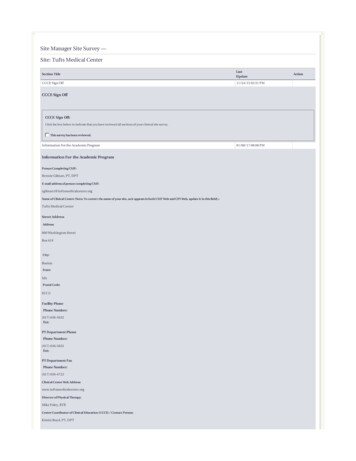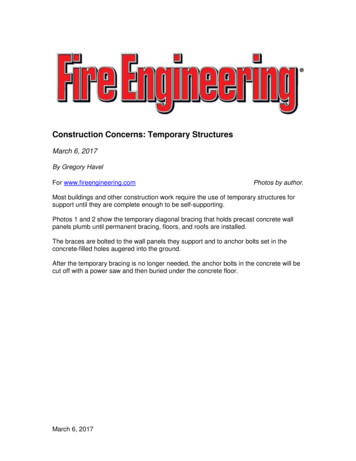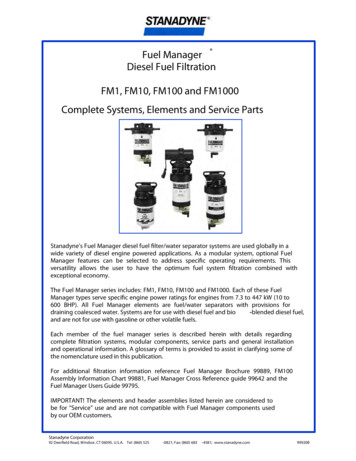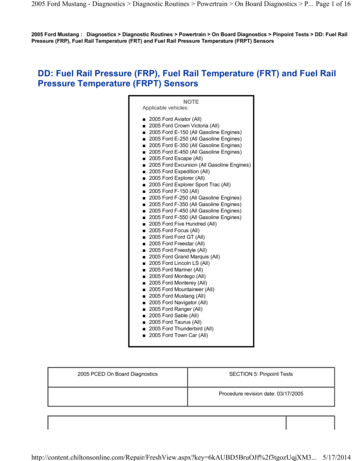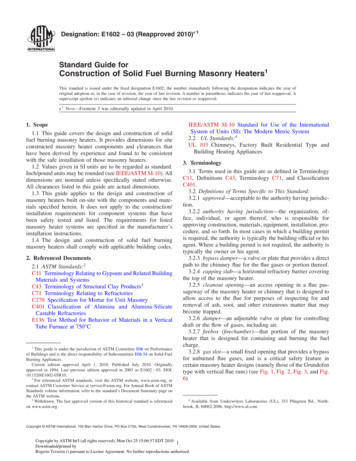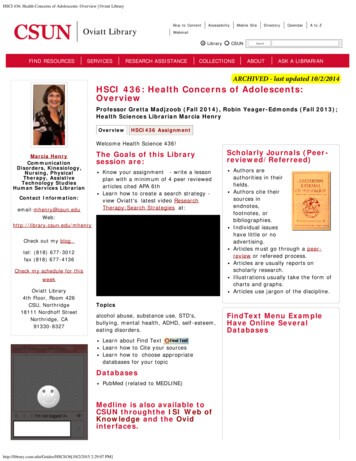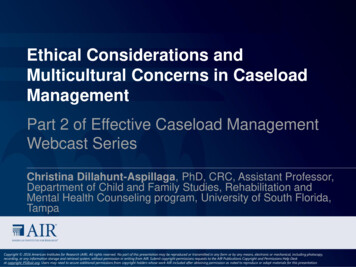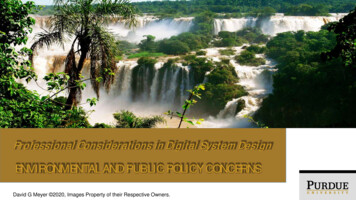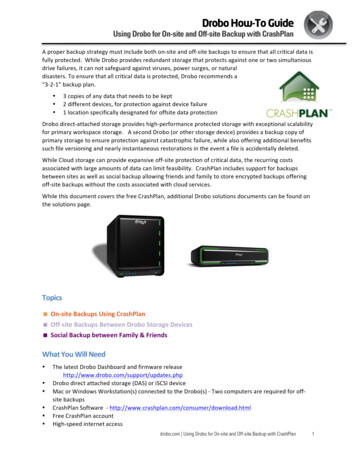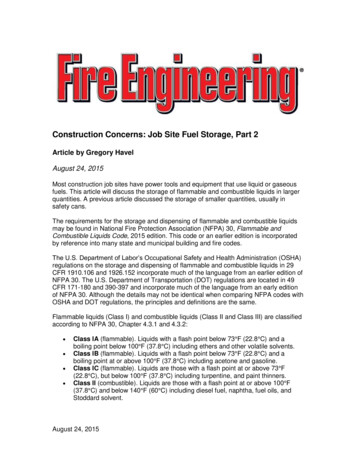
Transcription
Construction Concerns: Job Site Fuel Storage, Part 2Article by Gregory HavelAugust 24, 2015Most construction job sites have power tools and equipment that use liquid or gaseousfuels. This article will discuss the storage of flammable and combustible liquids in largerquantities. A previous article discussed the storage of smaller quantities, usually insafety cans.The requirements for the storage and dispensing of flammable and combustible liquidsmay be found in National Fire Protection Association (NFPA) 30, Flammable andCombustible Liquids Code, 2015 edition. This code or an earlier edition is incorporatedby reference into many state and municipal building and fire codes.The U.S. Department of Labor’s Occupational Safety and Health Administration (OSHA)regulations on the storage and dispensing of flammable and combustible liquids in 29CFR 1910.106 and 1926.152 incorporate much of the language from an earlier edition ofNFPA 30. The U.S. Department of Transportation (DOT) regulations are located in 49CFR 171-180 and 390-397 and incorporate much of the language from an early editionof NFPA 30. Although the details may not be identical when comparing NFPA codes withOSHA and DOT regulations, the principles and definitions are the same.Flammable liquids (Class I) and combustible liquids (Class II and Class III) are classifiedaccording to NFPA 30, Chapter 4.3.1 and 4.3.2: Class IA (flammable). Liquids with a flash point below 73 F (22.8 C) and aboiling point below 100 F (37.8 C) including ethers and other volatile solvents.Class IB (flammable). Liquids with a flash point below 73 F (22.8 C) and aboiling point at or above 100 F (37.8 C) including acetone and gasoline.Class IC (flammable). Liquids are those with a flash point at or above 73 F(22.8 C), but below 100 F (37.8 C) including turpentine, and paint thinners.Class II (combustible). Liquids are those with a flash point at or above 100 F(37.8 C) and below 140 F (60 C) including diesel fuel, naphtha, fuel oils, andStoddard solvent.August 24, 2015
Class IIIA (combustible). Liquids are those with a flash point at or above 140 F(60 C), but below 200 F (93 C) including kerosene, some fuel oils, andnitrobenzene.Class IIIB (combustible). Liquids are those with a flash point at or above 200 F(93 C) including formalin, motor oils, and some fuel oils.Larger quantities of flammable and combustible liquids on construction job sites,especially those used as motor and heating fuels, must be stored in and dispensed fromtanks that are labeled with the name of their contents as well as hazard warnings andhazardous materials placards if the tanks have a capacity of 1,001 pounds (454 kg) ormore.According to manufacturer MSDS/SDS, gasoline weighs 6.0 pounds per U.S. gallon,while diesel fuel weighs 7.0 pounds per U.S. gallon. One-hundred-and-forty-three (143)gallons (541 l) of Number 2 diesel fuel weighs 1,001 pounds (454 kg), while 167 gallons(632 l) of gasoline also weighs 1,001 pounds (454 kg).Photo 1 shows a tank trailer provided by a fuel supplier for use on a construction job site.It contains diesel fuel that is suitable for use in off-road construction machinery.(1)The advantage to a fuel tank that is mounted on a trailer or truck chassis is that it can bemoved from one location to another on the job site as required. This tank has a verticalatmospheric vent with a flame arrester on top of the tank. The dispensing pump, meter,and fuel hose are locked in the black box at the end of the trailer.August 24, 2015
Photo 2 shows a skid-mounted fuel tank provided by a fuel supplier on a differentconstruction job site.(2)It contains diesel fuel that is suitable for use in off-road construction machinery. From leftto right in the photo, this tank has the following equipment required by NFPA 30: A vacuum/pressure vent cap.A hoisting lug for lifting and moving the (empty) tank with a crane.A second vacuum/pressure vent cap.A float-type fuel level indicator.The electric fuel-dispensing meter and pump.The steel skid base that is welded to the bottom of this tank has pockets for a forklift andfor moving the tank empty or partially filled.Photo 3 shows the other end of the tank in Photo 2.August 24, 2015
(3)This tank has a double wall so that any leakage from the inner fuel tank will be containedby the outer tank. The following is shown in the photo (from right to left): The vertical atmospheric vent pipe with a flame arrester and vent cap at the top.The locked fill cover with overfill protection.A float-type fuel level indicator installed in the vertical pipe at the left end of thetank is connected to the bottom of the space between the inner tank and its outercontainment. Normally, this indicator shows “Empty.” It takes only a small amountof leakage into the space between the two tanks for this indicator to show a leak.This is the same type of tank that is often used at fixed facilities; it needs no additionaldiking or other containment because it is all self-contained.On construction job sites, as at any fixed facility, these types of fuel tanks cannot belocated inside of buildings; they must be located at a distance from property lines andfrom any structure while being protected from damage from traffic as required by NFPA30 and building and fire codes.The key points in the storage of flammable and combustible liquids on construction jobsites and in commercial occupancies follow: Store these products in approved tanks or safety cans, as required by NFPA 30,and building and fire codes.August 24, 2015
Never dispense combustible or flammable liquids inside buildings.Never fuel motorized vehicles, equipment, or power tools close to buildings orother structures.Have a Class B fire extinguisher of the proper size in the area where flammableor combustible liquids are dispensed or used; as required in NFPA 10, Standardfor Portable Fire Extinguishers.NFPA Codes and Standards are available by subscription in print or online versions.Check with your fire prevention bureau for access to these publications or visit the libraryat your local technical college or regional fire training center.OSHA regulations are available for downloading at no charge at www.osha.gov.U.S. DOT regulations are available for downloading at no charge at www.dot.gov.Federal Motor Carrier Safety Administration regulations are available for downloading atno charge at www.fmcsa.dot.gov.Gregory Havel is a member of the Town of Burlington (WI) FireDepartment; retired deputy chief and training officer; and a 30-yearveteran of the fire service. He is a Wisconsin-certified fire instructorII, fire officer II, and fire inspector; an adjunct instructor in fireservice programs at Gateway Technical College; and safety directorfor Scherrer Construction Co., Inc. Havel has a bachelor's degreefrom St. Norbert College; has more than 30 years of experience infacilities management and building construction; and has presentedclasses at FDIC.CLICK HERE for more 'Construction Concerns' articles!MORE CONSTRUCTION CONCERNS Job Site Fuel Storage, Part 1Porches, Decks, and StairsFuels and Fire BehaviorBlocked Emergency ExitsTypes of Gypsum Drywall BoardRadiant Floor Heating PanelsVertical Rolling Fire DoorsMisleading MarketingFire DoorsSnow LoadAugust 24, 2015
The U.S. Department of Labor’s Occupational Safety and Health Administration (OSHA) regulations on the storage and dispensing of flammable and combustible liquids in 29 CFR 1910.106 and 1926.152 incorporate much of the language from an earlier edition of NFPA 30. The U.S. Departm
